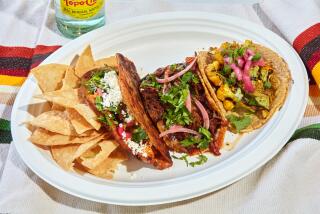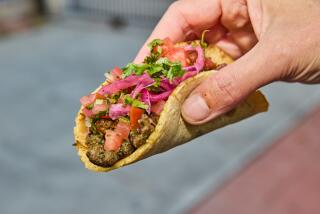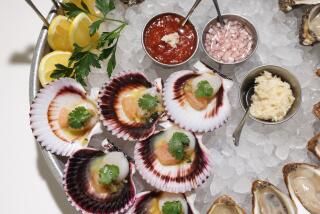10 Hawaiian specialties to sample
Honolulu
You will likely travel to Hawaii thinking of coconut and pineapple as your only tropical flavors. But let go of that.
Seek out these only-in-Hawaii foods in the true spirit of adventurous eating.
TRY IT HERE
Spam musubi: People from the mainland are often amused by Hawaiians’ affinity for Spam. But do not mock us. We’re on to something. For proof, sample the No. 1 picnic food: Spam musubi.Musubi is a Japanese rice ball -- triangular and wrapped in a strip of nori, or roasted seaweed. Spam musubi is brick-like: rice on the bottom, a slab of Spam on top. It’s salty, like Spam, but the rice absorbs the greasiness, and the seaweed wrapper provides that bit of umami.
It’s a favorite at picnics and at the 19th hole on the golf course. Soccer moms make them by the dozens for post-game snacks.
Acrylic molds are widely available for shaping the rice, but you can buy servings of Spam musubi ready-made for less than $2 at convenience stores or in the deli section of supermarkets.
Loco moco: This uniquely Hawaiian food is easily described but not as easily explained. Imagine a scoop of rice topped with a hamburger patty, topped with a fried egg, topped with lots of brown gravy.
This double-protein tower is eaten for breakfast, lunch, dinner or as a between-meal snack.
You can find a loco moco at almost any family-style restaurant. Even upscale restaurants offer versions. At Alan Wong’s Pineapple Room in Ala Moana Center, you can have one with grass-fed local beef, fried rice and veal jus.
Manapua: In the Chinese dim sum repertoire, this would be called bao -- a pure-white bun filled with char siu (roast pork).
The Hawaiian version is bigger and better, sized more like a softball than a baseball, stuffed tight with shredded meat. Along with char siu, other ingredients have become fusion favorites, such as curry chicken, sausage and even sweet potato.
Snowy white, steamed manapua is the standard, but many aficionados prefer the baked version. Both are easy to find at takeout counters and convenience stores, but the best are in shops that specialize in dim sum. Chinatown is a good bet.
Manapua can be purchased chilled or frozen to carry home.
Coco puff: These sweet treasures are sold by the thousands every year, at Liliha Bakery, about five miles from the tourist center of Waikiki.
A coco puff is a cream puff but somehow better, filled with chocolate cream and topped with a buttery frosting called Chantilly here. (Classic French Chantilly, a sweetened cream topping, often with nuts or fruit mixed in, is very different.)
Cream puffs are sold at bakeries all over town, lovely but much like what you can find at home. The coco puff is a distinctive local favorite. The bakery, a 57-year-old family establishment with an old-style lunch counter, is also worth a visit, if you can get a seat.
Info: (808) 531-1651, 515 N. Kuakini St.
Guava chiffon cake: This light, refreshing cake was developed at Dee Lite Bakery, opened in 1959 by Herbert and Sue Matsuba in downtown Honolulu. He was the baker and came up with a guava-flavored chiffon cake, later expanding to passion fruit and rainbow (guava, passion fruit and lime). The tropical flavors baked into the cake also go into a creamy filling between layers.
The formula is widely copied, and you’ll find respectable versions in bakeries, restaurants and even supermarket bakeries. For the original, seek out a Dee Lite or Saint-Germain bakery; find locations at www.stghi.com. (The Japan-based Saint-Germain bought out the Matsubas in 1990.)
TAKE IT HOME
You can carry chocolate-covered macadamia nuts back from your Hawaii vacation, but really, you can find those at home. Here are five better ideas, more distinctly Hawaiian and easy to pack.Hawaiian coffees: Kona coffee is the standard bearer, but every island in the chain produces a signature bean.
Pure Kona is expensive, but Kona blends, sometimes flavored with chocolate, coconut or macadamia, are affordable. Or seek out a coffee from Kauai, Maui or Molokai. Oahu’s coffee is called Waialua for the North Shore town where it’s produced.
Best place to buy: Longs Drugs stores, where one brand or another is always on sale for about $4 per 10-ounce bag.
Hawaiian cookies: These are boxed for travel and gift-giving, and a variety of locally made cookies makes a good office peace offering.
A good example: pineapple-shaped Honolulu Cookie Co. treats, individually wrapped to keep fresh. The mac-nut shortbreads come dipped in chocolate or with a bit of dried tropical fruit or a coffee bean tucked in like a little belly button.
Shops are in Ward Warehouse, Ala Moana Center and the Hilton Hawaiian Village.
Portuguese sausage: This spicy blend is so deeply ingrained that it’s even served at McDonald’s in Hawaii. The taste is so distinctive that when locals move away they frequently complain they can’t find anything like it. Portuguese linguiça comes closest, but it’s not quite the same.
You can find many varieties at any supermarket and carry them home in a thermal bag.
Hurricane popcorn: These microwave-popcorn packs are virtually indestructible. The basic blend with arare (Japanese rice crackers) and furikake (roasted seaweed blend) is a snack-attack favorite.
If you have friends who are former islanders, take them some, and you’ll be a hero.
Available at drug and discount stores for $3 to $4 per bag.
Hawaiian chocolate: Many local companies make fancy chocolate candies, but only two use pure Hawaiian-grown chocolate -- Original Hawaiian Chocolate Factory and Waialua Chocolate. Cocoa content on both is high -- 60% to 70% for the dark chocolates. You’ll have to seek out a specialty shop. Go to www.originalhawaiianchocolatefactory.com for locations.
For Waialua Chocolate, visit the Dole Plantation on Oahu’s North Shore ( www.dole-plantation.com).
Betty Shimabukuro is the food editor for the Honolulu Star-Bulletin. Her second cookbook, “What Hawaii Likes to Eat,” was released last month.
Comments? Email travel-feedback@latimes.com
More to Read
Sign up for The Wild
We’ll help you find the best places to hike, bike and run, as well as the perfect silent spots for meditation and yoga.
You may occasionally receive promotional content from the Los Angeles Times.






